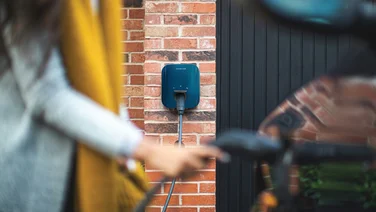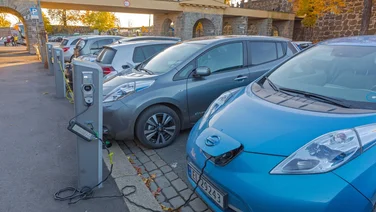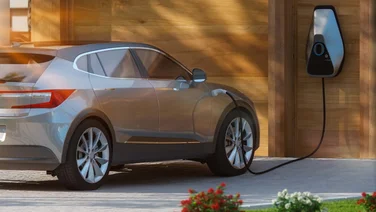- How does EV charging work?
- AC vs DC electric vehicle charging
- On board charging system for electric vehicles
- Electric vehicle charging capacity
- Electric vehicle charging plug types
- Charging at home
- Charging on public networks
- Electric vehicle charging tariffs
- What is the electric vehicle charging logo?
- Top 7 tips for EV charging
- Next steps
- It’s twice as cheap to run an electric car than a petrol model
- There are 3,600 more electric charging locations than petrol stations
- The average modern electric car has over 200 miles of range
Electric cars represent a tangible to lower your emissions. They’re also sleek, futuristic – and cheap to run. An electric car charging point costs £1,000 on average, and can save you £664 per year.
That makes an EV two times less expensive to charge and run than its petrol-powered equivalent. Plus, the industry is always evolving, with advances like wireless EV charging now emerging in the UK.
But before you jump in, you want to know how to keep them charged. That’s fair enough. In this guide, we’ll run you through the different options for recharging your car, and let you know how to use them.
Fill in this form to see how much a home charger would cost you.
Get free EV charging point quotes
Answer a few quick questions, and our trusted installers will send you bespoke EV charging point quotes – for free.
How does EV charging work?
An electric car needs refuelling, same as any vehicle. For this advanced mode of transport, all you’ll need to do is plug it in to an electricity source, and leave it for a while. That’s it.
It’s just like charging your phone, in that each type of model will require a different kind of cable to make the connection.
There will be a port on your car and another on your chosen charging station, and your cable will need to plug in to both of them.
We’ve laid out below which connector matches with each charging station, and once you’ve got that straight, the only major difference is the speed and the price you pay for it.
AC vs DC electric vehicle charging
When you charge an electric car, alternating current (AC) from the grid has to be turned into direct current (DC), which your vehicle can use.
If you get an DC charger, it will perform the conversion. If you opt for an AC charger, your car will turn that AC into DC – but much more slowly.
This is the main difference between the slower, AC chargers – confusingly known as slow and fast, but more on that later – and the faster, DC chargers, which are called rapid and ultra-rapid.
It’s why AC chargers cap out at 22kW, while DC chargers can reach 100kW or above.
Inevitably, this makes DC chargers more expensive, but they may still suit your purposes better than their AC counterparts.
On board charging system for electric vehicles
Your electric car can use its on board charging (OBC) system to convert AC from your charging station into DC.
Electric vehicles are powered by DC, so this is a necessary feature of your car – unless your charger carries out this AC-DC conversion.
It’s typically quicker for your charger to perform the conversion – and OBCs can only reach a maximum of 22kW – but if it’s called upon, your car’s OBC will be more than capable of stepping in.
Electric vehicle charging capacity
There are four speeds of electric vehicle connector: slow, fast, rapid, and ultra-rapid.
Would it be less confusing if they were called slow, medium, fast, and fastest? Yes. But we don’t live in a perfect world.
These connectors determine how quickly you can charge your electric vehicle.
Home chargers are typically slow or fast, while most public charging points are fast – though some are rapid or ultra-rapid.
Bear in mind that even though charging your car quickly sounds great, a slow charging station could be your best, most cost-effective option.
Despite all of these options, only 55% of people would have an EV if it were free, according to our National Home Energy Survey.

Slow units
Slow charging stations are generally between 3kW and 7kW, and can be found at homes or workplaces.
Just like fast units, they use Type 1 or Type 2 connectors to deliver alternating current (AC) from the grid to your car, which will use its converter to change it into direct current (DC).
It’s possible to plug your electric vehicle into an ordinary three-pin socket – the same kind you use to charge your phone – but it’ll be slow going, at just 2.3kW.
You’re better off getting a dedicated home station that can reliably – and cheaply – recharge your car overnight, and which is designed to transmit that level of electricity for hours at a time.
Fast chargers
These come in models from 7kW to 22kW, and are found everywhere.
They’re the Goldilocks’ porridge of chargers – slow enough for homes and businesses, but fast enough for public stations.
Most are 7kW, which is more than fast enough for overnight charging.
A small number are 22kW, but these are usually reserved for large businesses and their employees.
Rapid chargers
Welcome to the fast lane. This is where you can find your high-speed DC chargers, at 50kW to 100kW.
You’ll usually only find rapid and ultra-rapid units in public places, where they cost a lot more than you’ll pay for domestic electricity.
Don’t worry about buying a cable to connect to the charger, though – all DC charging stations come with tethered cables which can fit snugly into your car’s connector.
Ultra-rapid chargers
Ultra-rapid charging stations are faster than a speeding bullet, at 100kW or more.
That means that in mere minutes, you’ll be good to go.
The best charger currently available in the UK is 350 kW, allowing the fastest charging electric car – the Hyundai IONIQ 6 Long Range 2WD – to go from 10% to 80% charged in just 16 minutes.
The downside of these chargers is their price, which like their rapid counterparts can often be horribly excessive when compared to home charging stations.
Electric vehicle charging plug types
There are several types of electric vehicle charger.
Which one you choose depends on your vehicle and how intense your need for speed is.
Three-pin plug

This is the standard plug that you use to power everything from your mobile phone to your laptop and TV.
As mentioned above, though you can technically use them to charge your electric car, they’re not particularly suitable.
At 2.3kW, they’re far too slow – plus they’re not built for powering a vehicle, which means they can be unstable. We don’t recommend using them.
Type 1 and Type 2

Type 1 and 2 plugs are used to charge at ‘slow’ or ‘fast’ speeds.
Type 1 plugs can reach a maximum of around 7kW, while Type 2 chargers can go all the way up to 22kW, if your car is enabled for this level of charging.
For now, Type 2 plugs are more popular than all others, and come with most new electric cars – but of course, technology moves quickly.
CHAdeMO and CCS

If your vehicle is built for rapid or ultra-rapid charging, it’ll have either a CHAdeMO or CCS connector – unless you use a Tesla Supercharger, which requires a Type 2 connector.
These plugs can charge your car at speeds of 50kW, 100kW, and above.
Charging at home
How to charge an electric vehicle at home
You’ll need a home charging station.
Once it’s been set up, all you’ll need to do is plug one end of your cable into the unit, and the other end into your car.
And then it’s just a matter of plugging it in when you need a charge.
Maybe you want to leave it charging every night, or maybe once per week is enough for you. It all depends how often you drive, and which vehicle you own.
If you want to see which models are the best around right now, check out our article on the best electric vehicle home chargers.
Charging on public networks
The UK’s charging network
There are 21,378 locations in the public charging network, according to the latest data from Zap-Map.
That’s significantly more than the 8,386 petrol stations currently available nationwide, according to the UK Petroleum Industry Association’s 2022 report.
A small, shrinking number of these electric charging stations are free, but most require you to pay considerably more than you would at home, often after you’ve already paid a subscription fee.
But if you need to use one, all you’ll need to do is check your car’s connector type, and then find a charging station nearby.
You can do this by checking Zap-Map, which has a database of UK charging stations.
Just pop in your connector type and choose the speed of charge you’d like, and you can see all your local charging spots.
Make sure to have a look at whether there are any free stations, as it might be worth driving a little further to save some money.
Also, be aware that it’s not a guarantee that the charging station you visit will work. We recently investigated why so many EV chargers seem to be broken in the UK.
Either way, it’s clear the UK’s charging network needs to expand, as the results of The Eco Experts’ National Home Energy Survey shows. 69% of UK residents say they’d buy an EV if money were no object.
A further 17% plan to buy one in the next 12 months, making the need to increase charging stations (both public and residential) a pressing issue.
Charging at work
Hopefully your company is forward-thinking enough to provide its staff with electric vehicle charging stations.
If so, all you have to do is park next to one of the units, plug your cable into the right outlet, and go through your workday safe in the knowledge that you’re recharging your car for free.
And if your employer hasn’t installed any units yet, you might want to tell them about the Workplace Charging Scheme.
As long as their business is eligible, this scheme will cover 75% of their charging point costs, up to £350, for as many as 40 units across multiple sites.
That’s a potential saving of £14,000, which shouldn’t be sneezed at – and you’d get to charge your car for free.
Electric vehicle charging tariffs
At home
Charging your electric vehicle at home is the cheaper, more cost-effective choice.
The average domestic electricity tariff is 28.62p per kWh (kilowatt-hour), and the average electric vehicle has a maximum charge level of 65.3 kWh, according to the EV Database. On a 28.62p per kWh tariff, this means paying £19.72 for a full charge.
The average electric vehicle can go 220 miles on a full battery, which means you’ll be paying around 9p per mile.
In comparison, the average 55 litre petrol car now costs £81.39 to fully refuel.
This means the average petrol car, which runs for 436 miles on one tank, costs 19p per mile to refuel – around twice as expensive as electric vehicles.
In public
Charging in public will almost always be more expensive than home charging, but it’s usually quicker.
For example, BP Pulse charges you £94.20 per year, then another 55p or 59p per kWh to use a sufficiently quick charger.
Prices are rising all the time, so you’re unlikely to find any charging stations that cost less than domestic electricity.
Generally, public charging should be reserved for emergencies, as it’s a drain on your wallet and your time.
Either way though, you’re winning with an electric vehicle.
If you want to learn exactly how much money purchasing one could save you over the years, just use the calculator below – and make sure to check out our electric vehicle statistics page.
What is the electric vehicle charging logo?
There isn’t an official symbol for electric vehicle charging locations.
The sign below is relatively common, but it’s not the only one – so keep your eyes peeled.
Many feature a car on a green background or next to a plug.

Top 7 tips for EV charging
1. Home charging is cheaper and more reliable
2. Don’t use a three-pin socket, though – they’re especially slow, and aren’t built to sustain a charge for that long
3. Slow chargers will take hours, rapid chargers will take minutes
4. Check your connector to make sure what kind you have, so you’ll always know which charging station you need
5. DC charging stations supply cables; AC stations don’t, so bring your own
6. Drive soon after you’ve fully charged your car – it’s better for your battery
7. Tell your employer about the Workplace Charging Scheme to boost their eco-friendly credentials and net yourself a way of charging for free
Next steps
Well done! If you’ve made it this far, give yourself a round of applause. You’ve graduated from electric car charging school, and are ready to get your own vehicle.
You know about all the different speeds and outlets you need to be aware of, and you know that home charging is cheaper and more reliable than public charging.
So what are you waiting for? Go get the car that’s three times cheaper to run than the average petrol car, and that can be recharged with your own personal discounted refueling station.
If you’d like to see how much a home or business charging point would cost, fill in this form.






